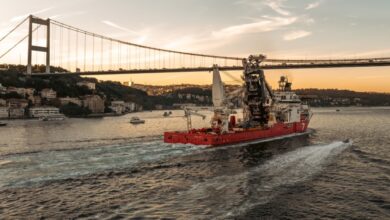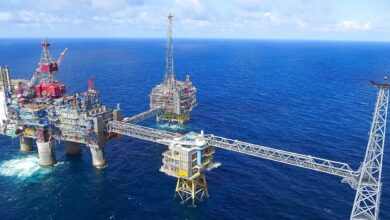CSB report: Macondo BOP failed due to unrecognized pipe buckling during well control efforts

The blowout preventer (BOP) that was intended to shut off the flow of high-pressure oil and gas from the Macondo well in the Gulf of Mexico failed to seal the well because drill pipe buckled for reasons the offshore drilling industry remains largely unaware of, according to a report released earlier this month by the US Chemical Safety Board (CSB). The CSB report concluded that the pipe buckling likely occurred during the first minutes of the blowout. Although other investigations had previously noted that drill pipe in the wellbore was found in a bent or buckled state, this was assumed to have occurred days later, after the blowout was well under way.
IADC is studying the two-volume report but currently sees nothing to cause it to deviate from its intensive program of work to support broad improvements in the drilling industry and in well control, reliability and training standards.

Click here to download an overview of the report.
Click here to download Volume 1 of the report.
Click here to download Volume 2 of the report.
After testing individual components of the BOP and analyzing data from post-accident examinations, the CSB concluded that the BOP’s blind shear ram likely did activate on the night of the accident, days earlier than other investigations found. However, the pipe buckling that likely occurred on the night of 20 April prevented the blind shear ram from properly functioning. Instead of cleanly cutting and sealing the drill pipe, the shear ram punctured the buckled, off-center pipe, according to the report.
The identification of the new buckling mechanism for the drill pipe – called effective compression – was a central technical finding of the report. The report concluded that, under certain conditions, the effective compression phenomenon could compromise the proper functioning of other BOPs still deployed around the world in offshore wells. The complete BOP failure scenario is detailed in a new 11-minute computer video animation the CSB developed and released with the report.
The report makes recommendations to the US Bureau of Safety and Environmental Enforcement to require operators to effectively manage technical, operational and organizational safety-critical elements to reduce major accident risk to an acceptably low level, known as “as low as reasonably practicable.” The report also proposes recommendations to the API to revise API Standard 53, Blowout Prevention Equipment Systems for Drilling Wells, calling for critical testing of the redundant control systems within BOP and for new guidance for the effective management of safety-critical elements in general.

“The CSB analysis in Volume 2 is focused on the BOP and the particular technical aspects of the BOPs. Yet, well control in particular, and safe operations in general, are an entire system of technology, people and processes, and thus a systems-based approach is essential for safe operations,” Charlie Williams, Executive Director for the Center for Offshore Safety, said. “The focus cannot be just on the equipment. The report itself notes that many safety system processes were done at Macondo, like hazard analysis, barrier analysis and management of change. Thus, the report should do more to analyze these safety management processes and make recommendations on how they can be enhanced and made more effective. Significant strides of safety are directly related to implementation of a systems-based approach, such as SEMS (Safety and Environment Management Systems) and operationalizing these systems in the field.”
The CSB report also revealed that there were two instances of mis-wiring and two backup battery failures affecting the electronic and hydraulic controls for the BOP’s blind shear ram. One mis-wiring, which led to a battery failure, disabled the BOP’s blue pod – a control system designed to activate the blind shear ram in an emergency. The BOP’s yellow pod – an identical, redundant system that could also activate the blind shear ram – had a different mis-wiring and a different battery failure. In the case of the yellow pod, however, the two failures canceled each other out, and the pod was likely able to operate the blind shear ram on 20 April.
“Although both regulators and the industry itself have made significant progress since the 2010 calamity, more must be done to ensure the correct functioning of blowout preventers and other safety-critical elements that protect workers and the environment from major offshore accidents,” said Dr Rafael Moure-Eraso, the CSB chairperson. “The two-volume report we are releasing today makes clear why the current offshore safety framework needs to be further strengthened.”
“The CSB’s model differs from other buckling theories that have been presented over the years but for which insufficient supporting evidence has been produced,” according to CSB Investigator Dr Mary Beth Mulcahy, who oversaw the technical analysis. “The CSB’s conclusions are based on real-time pressure data from the Deepwater Horizon and calculations about the behavior of the drill pipe under extreme conditions. The findings reveal that pipe buckling could occur even when a well is shut in and apparently in a safe and stable condition. The pipe buckling – unlikely to be detected by the drilling crew – could render the BOP inoperable in an emergency. This hazard could impact even the best offshore companies, those who are maintaining their blowout preventers and other equipment to a high standard. However, there are straightforward methods to avoid pipe buckling if you recognize it as a hazard.”
Two more volumes of the CSB’s Macondo investigation report are planned to address additional regulatory matters, as well as organizational and human factors safety issues raised by the accident.




